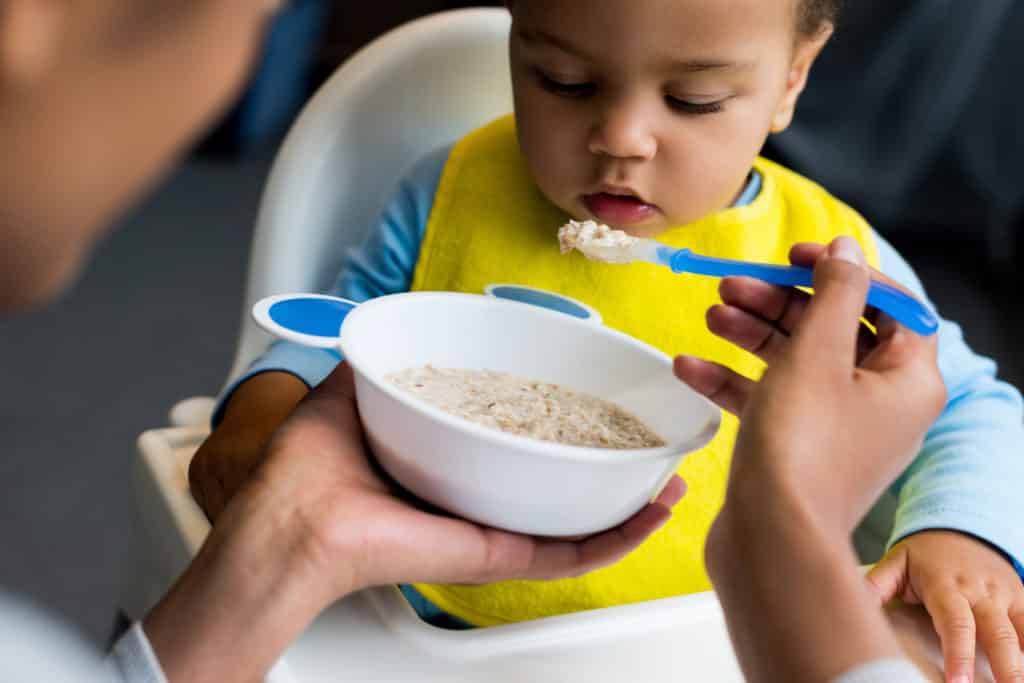
Source: Shutterstock
Baby Fola was already 6months old. Her parents loved and adored her so she never lacked anything. Her mother, Sade, was able to take some time off work so she could breastfeed her little one exclusively. Sadly, Sade’s break had come to an end and she had to go back to work. She had to start giving Fola solid food, but was uncertain about how to go about weaning.

Was Fola even old enough to be weaned? Sade didn’t know where to begin.
What Is Weaning?
Weaning is the introduction of solid food into a baby’s diet, while gradually stopping breastfeeding.
When Does It Start?
The WHO recommends children be fed breast milk till the age of 2 years. Milk should form a major part of your child’s diet within the first year of life. It has several benefits for mum and baby such as reducing the risk of breast cancer and obesity.
At first, breast milk is all your baby needs. However, after 6 months, your baby requires more nutrients that breast milk cannot provide. At this point, you need to introduce solid food. Keep on breastfeeding even after you introduce solid food.
This gives your baby time to adjust to the new diet.
Reasons For Weaning
Reasons for wanting a breastmilk production to stop could vary from :
- having to go back to work,
- reaching your breastfeeding target,
- You are tired and just wanting your body back (personal),
- having a baby or mother with a medical condition that is incompatible with feeding breastmilk or
- unfortunately if a mum looses her baby.
How To Start
Weaning can be either natural or planned.
Natural weaning is also called “child-led weaning”. In this case, your child determines the time and pace of weaning. It starts when your baby gradually begins to accept different types of food, while still breastfeeding. It’s best to start gradually, with one ingredient meals. We’ll discuss this in another article.
This continues till breastfeeding completely stops. This method of weaning might take some time, till your baby is about 2 years or more.

On the other hand, planned weaning or “mother-led weaning” is based on the mother. She chooses when to start the process. However, you should still wean gradually.
Begin by alternating solid food and breast milk. Introduce one food at a time. As your baby begins to adjust, you could then add a variety of meals.
How Can I Tell If My Baby Is Ready For Solids?
This usually coincides when your baby is around) months old but it varies from child to child. The signs of readiness to look out for include the following:
- They can sit up without support.
- They start showing interest in the food they see being eaten by others around them
- They loose the extrusion reflex; the tendency to push food out using the tongue instead of rolling it in and to the back of the mouth
Next Steps
- Gradually drop take off one feeding or pumping session every 2-3 days replacing this for baby with your desired semi solid meal. This tricks your baby and your body. For kids who are “aware” ie. over 1 year old you can substitute these sessions with healthy alternatives such as yoghurt or fresh fruit smoothies.
- Increase the time in between each feeding or pumping session eg. If you pumped or fed every 2 hours, increase the interval to 4 hours.
- Shorten the duration of each session. If your feeding or pumping sessions usually last 20-30 minutes, cut it down to 10 or 15.
- Gradually your baby should loose interest. This doesn’t mean your milk supply will dry up immediately. This will come with time.
Drastic measures…
You can stop Breastmilk production more abruptly using specific medication( diuretics or prolactin inhibitors). A doctor can prescribe this for you
How Can Weaning Affect You?
When you stop breastfeeding, your body experiences some physical and emotional changes. Some of these include;
- Mood swings
- Return of your periods
- Decrease in breast size
Additionally, your breast will continue producing milk for some time. Weaning gradually allows your breast milk supply to reduce little by little.
This is necessary to prevent your breast ducts ( which transport milk) from getting blocked and causing an infection.
How Can You Care For Your Breasts When Weaning Starts?
Your breastmilk supply obeys the laws of demand and supply after your baby turns 1 month old. The best way to reduce and finally stop your milk supply is to drain as little of your milk as possible. However, your breasts may become engorged with milk, your ducts may clog up and get blocked, causing discomfort and pain.

If this happens to you, you could try;
- Using warmth to help loosen up the clogged duct. This is done by taking warm showers, use hot compresses or a hot water bottle to massage your breasts. Please wrap in a towel before applying to your skin to prevent burns.
- Hand-expression or pumping to temporarily drain milk in the affected breast. This will help clear your ducts. You can do this with a silicone breast pump.
- Wearing a looser bra. Bras that are too tight especially those with underwires can lead to clogged ducts. We stock some comfort ones from Biamo designs.
If left untreated, a blocked duct could cause an infection called mastitis. This may need treatment with antibiotics. Your doctor may also recommend paracetamol or ibuprofen to help with the fever, pain and inflammation.
Once the blocked duct or mastitis is treated, you can resume not draining your milk. With time, your breast will decrease its milk supply till it eventually stops.
Do you….
Whether you are breastfeeding directly or pumping exclusively, the decision as to how and when to begin to WEAN your baby off breastmilk is yours.
Tricking your body to stop producing milk is another matter altogether. If this process isn’t handled well it could lead to undernourishment in your baby or complications from breast engorgement for example.
We’ve written on 10 Nigerian meal ideas you can try for weaning. Meals like pap and Tom Brown are mixed with soya bean powder are great once your baby gets the hang of your starter one ingredient purees.
It would be a big change for both of you physically and emotionally. So do what you think is best, in your own time. Seek support from family and friends when needed.
You’ve got this mama!
References
- Arpana M. Naik 2015, Pregnancy and Parenting, Healthy Women, Viewed on June 22, 2020, <https://www.healthywomen.org/content/ask-expert/1286/clogged-milk-duct>.
- Caring For Kids 2018, Weaning Your Child From Breastfeeding, Caring For Kids, Caring For Your Kids, Viewed on June 22, 2020, <https://www.caringforkids.cps.ca/handouts/weaning_breastfeeding>.
- First 1000 Days 2020, What Is Weaning & How To Get Started, First 1000 Days, Viewed on June 22, 2020, <https://www.first1000days.ie/what-is-weaning-how-to-get-started/>.
- Jessica Madden 2020, Engorgement, Mastitis + Thrush: What They Are and How To Treat Them, Motherly, Viewed on June 22, 2020, < https://www.mother.ly/life/engorgement-mastitis-thrush>.
- Medela 2019, Weaning; When and How To Stop Breastfeeding, Medela, Viewed on June 22, 2020, <https://www.medela.com/breastfeeding/mums-journey/weaning>.

